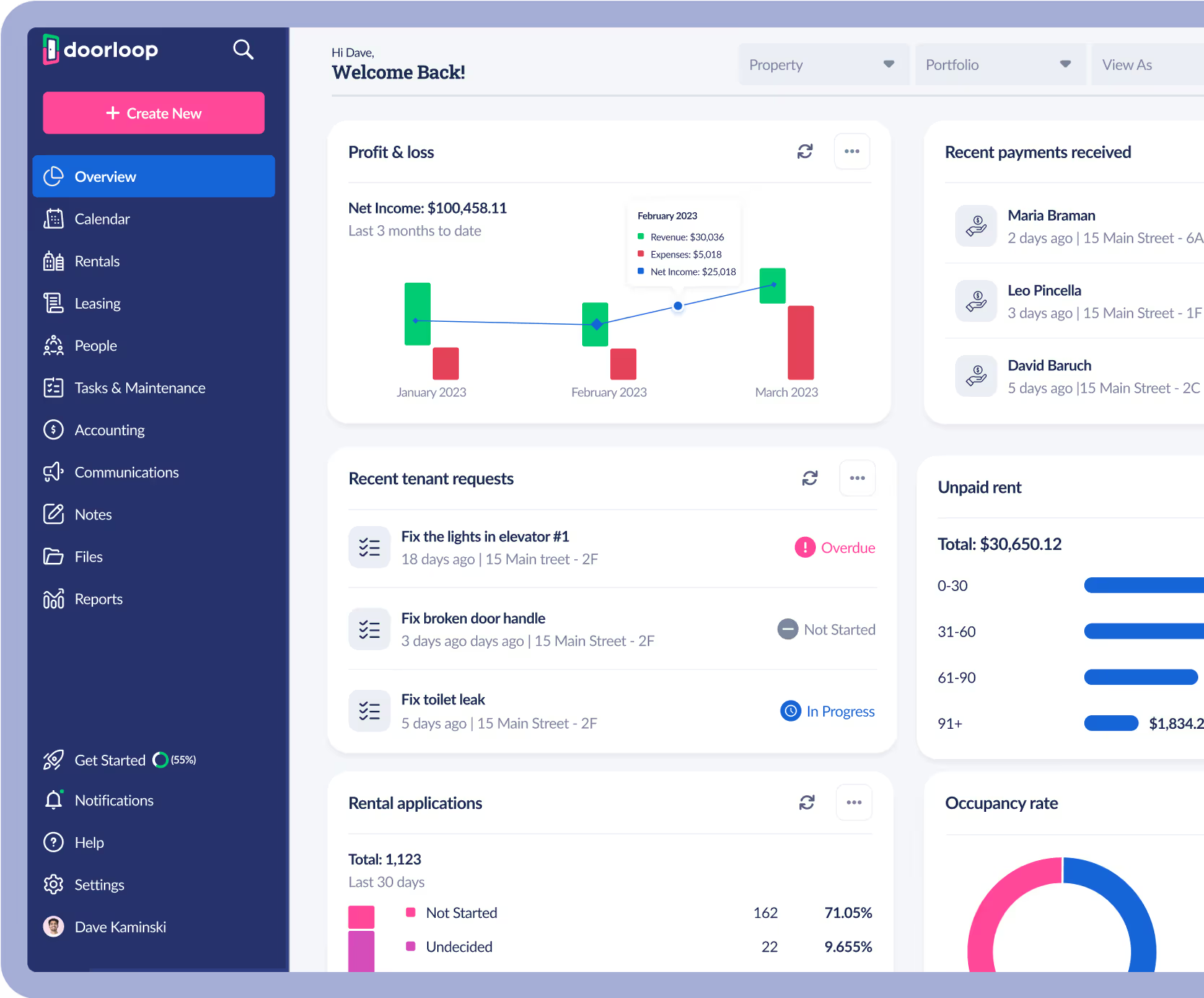Subletting: an opportunity for flexibility, or a potential headache?
As a landlord or property manager, you may have encountered situations where tenants want to sublet their rental property.
In this comprehensive guide, we’ll explore the world of subletting so that you can understand its ins and outs, confidently navigate the process, and protect the interests of both you and your tenants.
Understanding Subletting
Subletting involves a tenant renting out their rental property to another person, called a subtenant, under a lease or rental agreement. This process can take different forms, such as transferring the lease legally to someone else or renting out a room before the lease expires.
Subletting vs Subleasing
Although often used interchangeably, subletting and subleasing have distinct differences.
Subleasing occurs when a tenant rents out the property to someone else but remains responsible for the lease terms with the landlord.
In contrast, subletting involves setting up new lease agreements with the landlord, effectively transferring the responsibilities of the original renter to the subletter.
While subleasing keeps the original tenant on the hook for rental fees and damages, subletting typically requires landlord permission and the signing of a new lease agreement with the subletter.

Lessee vs Sublessor
In the context of subletting, a lessee is the original tenant who initially rented the property. The lessee’s role in subletting includes adhering to the lease agreement with the landlord and ensuring the sublease agreement follows the original lease.
A sublessor, on the other hand, is a tenant who leases out their property to a subtenant. This person is responsible for making sure the subtenant follows the sublease agreement and collects rent payments from them.
Pros and Cons of Subletting for Tenants
As a tenant, subletting can offer several advantages, such as flexibility in rental agreements and potential income. However, there are also potential risks and downsides to consider.
Pros
- Flexibility for temporary relocations, such as for a contract job or school
- Flexibility for leaving a property before the lease expires without penalty
- Opportunity for making some extra money
Cons
- Liability for damages caused by the subletter
- Liability for rent if the subletter doesn't pay
- Difficulty finding a reliable subtenant
Pros and Cons of Subletting for Landlords
As a landlord or property manager, subletting can offer both advantages and drawbacks.
Pros
- Continued tenant occupancy
- Opportunity for more income, such as through a sublet fee
- Improved property maintenance, as the original tenant may be more motivated to ensure the subtenant takes good care of the property
Cons
- Lack of control over who is living in their property
- Potential conflicts with rent collection or property damage
- Increased management responsibilities, such as screening subtenants and managing sublet agreements
- Additional laws and regulations to consider for subletting

The Role of Landlords and Property Managers in Subletting
When it comes to subletting, landlords and property managers play a crucial role in ensuring a smooth process for all parties involved. This includes:
- Screening potential subtenants
- Managing sublet agreements
- Communicating with both the original tenant and the subtenant
- Ensuring everyone is aware of their rights and responsibilities
How to Sublet a Rental Property
Subletting a rental property involves several steps to ensure a successful arrangement for both tenants and landlords.
Include a Sublet Clause in the Lease Agreement
To ensure tenants seek permission before subletting, include a sublet clause in the lease agreement. The sublet clause should outline:
- If a sublet or sublease is allowed
- The steps to take before finding a new tenant
- The landlord’s consent
- Screening requirements
- Insurance requirements
- Payment requirements
- Fees
Fees associated with subletting may cover administrative expenses related to the sublet, such as screening potential subtenants or preparing sublet agreements.
By including fees in the subletting clause, landlords can recover costs associated with the subletting process, and tenants are made aware of any additional expenses they may incur.
Give Consent
Landlord consent is a crucial component of a subletting clause, as it ensures that subletting is allowed under the lease agreement.
The clause should outline the conditions that necessitate the landlord’s approval, how to obtain their consent, and any restrictions or conditions they may impose on subletting.
You should always require that tenants seek your written permission to avoid them illegally subletting. This ensures that the landlord still has control over their rental property as well.
Determine If It's a Short-Term or Permanent Sublease
Determining if the sublease is short-term or permanent is important for establishing appropriate terms and conditions.
A permanent sublease takes place over an extended period of time. It's usually used when the existing tenant plans to leave and never come back.
Meanwhile, a short-term sublease is used for temporary or extended absence of the original tenant. If a tenant must travel out of state for a work assignment, family matter, school, or other specific circumstances, they might want a short-term sublease. This can last for however long is necessary and can range from anywhere between 30 days to even 6 months.
Considering the popularity of Airbnb and other types of short-term rentals, it's generally advised to put a limit on how short a short-term sublease can be to protect your property and avoid liability issues.
Screen the Subtenant
A property owner should screen each potential subletter to ensure they are reliable and responsible and will take good care of the rental unit. After all, you're essentially getting a new tenant. Like with regular tenant screening, this includes:
- Checking their credit history
- Checking their rental history
- Verifying their employment status
- Conducting a background check
- Verifying their references
- Following fair housing laws
Proper screening helps mitigate risks associated with subletting and protects both the tenant and the landlord.
Determine Payment Requirements
Payment requirements should be agreed upon by all parties and documented to avoid disputes and ensure everyone is aware of their financial responsibilities. This may include:
- Specifying the amount of rent
- The due date
- The payment methods accepted
- Any late fees that apply
By including payment requirements in the subletting clause, tenants and subtenants are reminded of their obligations, and landlords can ensure timely rent payments by emphasizing the importance of paying rent.
Require Insurance
Insurance requirements should be specified to protect the property and all parties involved. The clause should outline:
- The type of insurance needed
- The minimum coverage amount
- Who is responsible for obtaining and paying for the insurance
- Any additional requirements or exclusions
Proper insurance coverage minimizes potential disputes and ensures that all parties are protected.
That said, not all states allow landlords to require renters' insurance, so be sure to check with your local laws.
Sign a Sublet Agreement
Once a subtenant has been screened and approved, it’s essential to sign a legally binding sublet agreement to protect all parties involved. To make sure the agreement for the lease term is legally bound, you should include the following:
- Name of the subtenant
- Rent amount
- Lease term
- Any other conditions outlined in the original lease agreement
Make sure that the original renter is included in this signing. You should make sure that the responsibilities of all parties are outlined in this agreement as well, such as who pays rent or is responsible for damages moving forward. Also outline how you'll be collecting rent.
Rent Payments and Security Deposits in Subletting
Rent payments and security deposits play a crucial role in subletting arrangements. Here are some important considerations:
- The original tenant is typically responsible for rent payments
- The subtenant is responsible for any additional rent or fees associated with the sublet
- Security deposits should be handled in accordance with the lease agreement and local laws to protect both the tenant and the landlord
Ensuring proper management of rent payments and security deposits can help avoid disputes and maintain a smooth subletting process.
Subletting Risks and Legalities
Subletting can present risks and legalities for both tenants and landlords.
For tenants, there is the potential for property damage and the possibility that the subletter may not pay rent on time or at all.
For landlords, there may be the risk of not having control over who is living in their property and the primary tenant remaining responsible for unpaid rent or damages.
Being aware of these risks and legalities can help all parties involved navigate the subletting process and protect their interests.
What to Do If Your Tenant Sublets Without Your Permission
If a tenant sublets without your permission, it’s important to take action to ensure they are adhering to the lease agreement. This may include issuing a warning, charging a fee, or even evicting the tenant.
As a landlord, it’s crucial to have a clear subletting agreement with the tenant and to communicate the legal implications of subletting without permission and the potential consequences that may arise.
What to Do If the Tenant's Subletter Doesn't Pay the Rent
If the subletter doesn’t pay the rent, it’s essential for landlords to have a clear subletting agreement with the original tenant that outlines the responsibilities of the subletter. If the subletter continues not to pay rent, the landlord can take the necessary steps and file an eviction complaint.
In such cases, the tenant may also take legal action against the subletter if they don’t abide by the sublease agreement.
That said, when in doubt, you should always seek advice from a legal professional to understand your rights.
Alternatives to Subletting
While subletting can provide flexibility for tenants and landlords, there are also alternatives to consider. One such alternative is lease assignment, which transfers the lease to a new tenant without the landlord’s agreement. Lease buyouts and finding a new tenant to take over the lease are other alternatives to subletting.
Knowing the available options can help tenants and landlords decide which course of action best suits their needs and circumstances.
Importance of Documentation, Lease Management, and Communication
Proper documentation, lease management, and communication are crucial for a successful subletting arrangement.
Documentation ensures that all details of the sublease arrangement are officially recorded and can help prevent potential legal problems.
Lease management helps landlords, tenants, and subtenants stay aware of their rights and responsibilities and ensure compliance with lease terms.
Effective communication between all parties involved can help prevent misunderstandings and ensure a smooth subletting process.
Property management software like DoorLoop can help with all three of these!





























.svg)
.svg)

